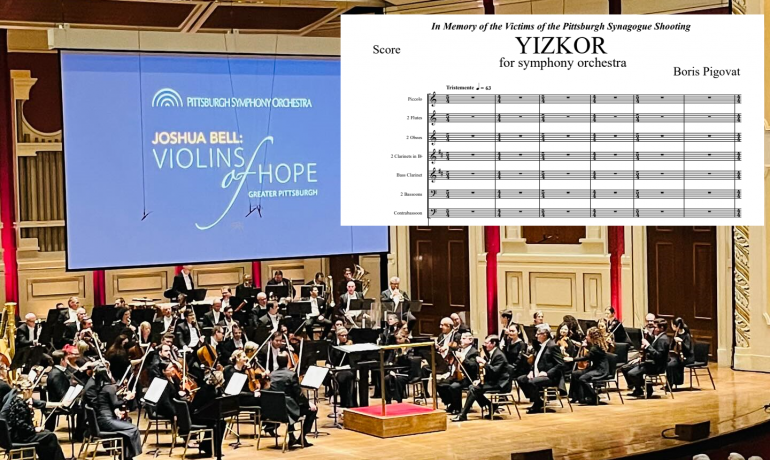
Category: Other

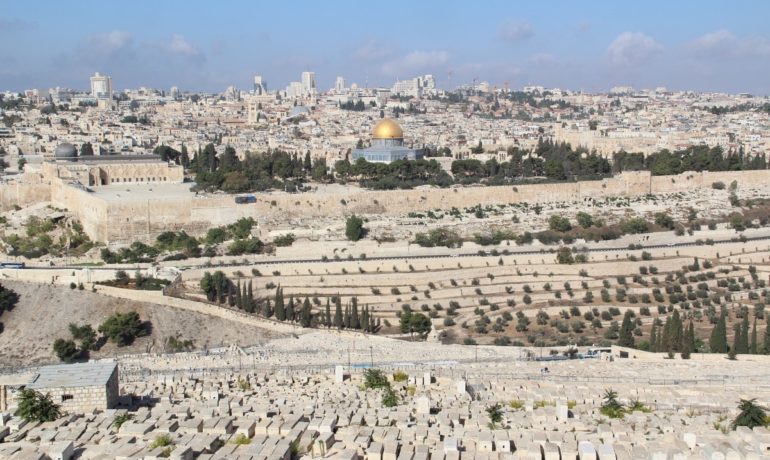
Jerusalem
- Duration: ca. 17 minutes
- SO: Picc, 2 Fls, 2 Obs, 2 Cls, B.Cl, 2 Bsns, C.Bsn, 4 Hns, 3 Tpts, 3 Tbns, Tba, Timp, Perc, Hp, Cel, Str.
- SWB: Picc, 2 Fls, Ob, Bsn, 3 Cls, B.Cl, 2 A.Sxs, T.Sx, B.Sx, 4 Hns, 5 Tpts, 4 Tbns, Bar, 2 Tbas, Harp, Str.B, Synth, Timp, Perc
The inspiration behind this work is a city at the centre of three religions – Judaism, Christianity and Islam, City whose name means “peace”, and whose fate is war, City which has known pain and joy, destruction and renewal, sadness and hope, City whose past is submerged in blood. As for its future… Would anybody dare to say that he knows it?
The poem Jerusalem exists in three versions: for solo piano, for symphonic wind band, and for symphony orchestra.
I wrote the piano version in 1991, and revised it in 2002 and in 2009.
Below is a recording of the 2002 version, performed by Michael Zelevinsky in Jerusalem.
The final piano version premiered in 2014 in Paris, at the first COMPETITION-FESTIVAL – modern piano repertoire, performed by Olivier Seuzaret.
Jerusalem for Piano was published in 2015 by Le CHANT du MONDE, Editions Musicales (in France).
In 2017, this work was performed several times by Albanian pianist Almira Emiri. Below is a recording from YouTube.
In 2012, I wrote the symphonic wind band version.
It was premiered in 2013 by the Petach-Tikva Conservatoire Wind Orchestra, conducted by Michael Delman.
Below is an audio recording of that performance. Although both the orchestra and the recording are not professional, the performance was very enthusiastic and presents a favorable rendition the work.
I wrote the initial version for symphony orchestra in 1993, shortly after I wrote the piano version. However, I was not satisfied with the result; I’ve added a lot of additional content to orchestral version, and the combination resulted in a musical structure that lacked cohesion.
After I wrote Holocaust Requiem in 1994-1995, my attitude towards orchestration changed. As result,I put aside Jerusalem until autumn 2017, when I prepared a new version.
Below are recordings of the piano solo version and of the symphonic wind band version.
Piano Solo version
Symphonic Wind Band version
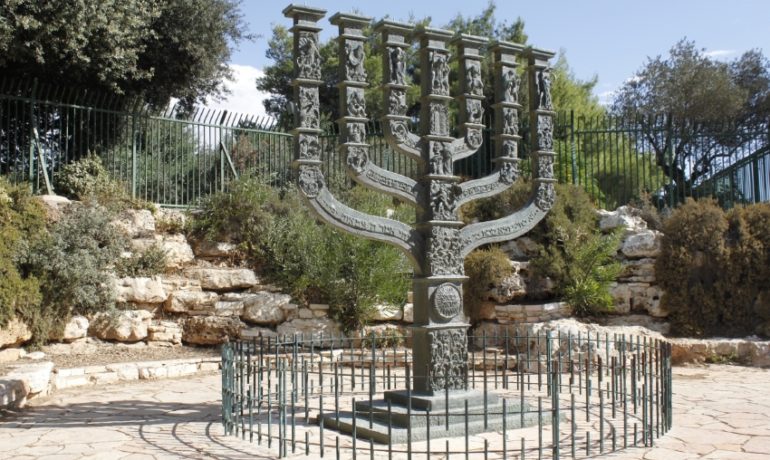
Nigun (1996)
For String Orchestra / String Quartet / Solo Viola / Solo Violin / Solo Violoncello
- Duration: ca. 5 minutes
The first version of Nigun was written in 1996, for string orchestra.
In this piece, I give expression to the tragic spirit that I feel in traditional Jewish music. However, there are no themes from traditional melodies in the piece. Rather, , the composition expresses the style and spiritual atmosphere of the ancient tunes.
The piece was premiered in Israel in 1997 by the Jerusalem Camerata, conducted by Horia Andreescu. Later it was performed by various orchestras in Israel and around the world.
In 1997, I prepared the version for solo violin. Unfortunately, this version has not yet been performed.
In 2008, I prepared the version for solo viola for the American violist Scott Slapin; he recorded it a few months later.
In 2010, I prepared the string quartet version for the Requiem CD (Atoll Records). This version is very similar to the 1996 version. However, I eliminated the contrabass part, and the opening unison of violas, violins and cellos I replaced with a violin solo. The piece was recorded by the Dominion String Quartet.
In 2017, I prepared the solo cello version for Israeli cellist Inbal Megiddo, who premiered it that autumn.
Below you can find recordings of various versions of Nigun.
Version for String Orchestra
Version for SOLO Viola
Samples from the "Requiem CD"
Dominion String Quartet
Donald Maurice, Viola
Yuri Gezentsvey, Violin
Rosemary Harris, Violin
David Chickering, Cello
2010
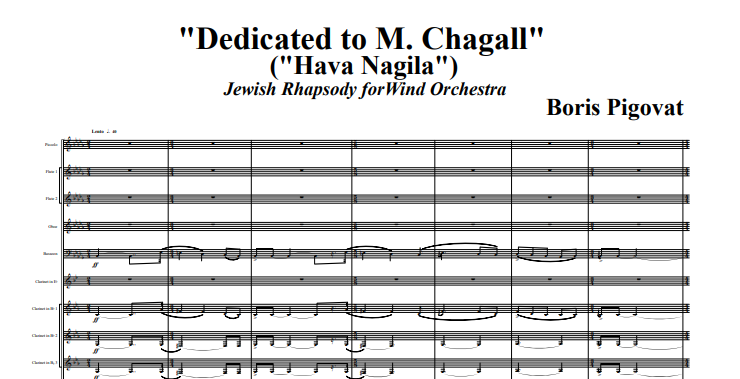
“Dedicated to Marc Chagall” (“Hava Nagila”)
Jewish Rhapsody for Wind Orchestra / String Orchestra (with Optional Piano) / Brass Ensemble / Saxophone Quartet / Solo Bayan
- Duration: ca. 9 minutes
My work Dedicated to Marc Chagall is based on the popular Jewish song Hava Nagila, which means Let us rejoice.
I had originally intended to write a rhapsody based on Hava Nagila, but I found myself writing episodes that were not derived from Hava Nagila. Suddenly, I realized that I was actually composing a tone poem, evoking scenes of a small Jewish town at the beginning of the 20th century. Such images and moods typify novels by Shalom Aleichem and the earlier paintings by Marc Chagall. I felt a particularly strong association to Chagall’s pictures. For this reason, I named the piece Dedicated to Marc Chagall, in addition to the secondary title of Jewish Rhapsody “Hava Nagila”.
I composed the piece in 2003, for wind orchestra, and then for string orchestra (with optional piano). The main part of both versions is similar, but the nature of strings required a completely different introduction for the string version.
The wind orchestra version premiered in 2003, performed by the Petach-Tikva Conservatoire Symphonic Band at Festival Kfar-Saba (in Israel), and conducted by Michael Delman.
The premiere of the string-orchestra was in 2005, performed by the Ramat Gan Chamber Orchestra (in Israel), and conducted by Aviv Ron.
Later, both versions were performed many times in Israel and around the world.
In 2015, the wind-orchestra version was also performed at the WASBE Conference in San Jose, California, by the Israel Youth Wind Orchestra, conducted by Motti Miron. Unfortunately, I don’t have a recording of that performance. However, below is the recording of a different performance of theirs, in Israel, in 2012:
In 2005, I was contacted by the Brandt-Brass Ensemble from Saratov, Russia. They sough a challenging piece to perform for international competition, and I prepared for them a version of Dedicated to Marc Chagall for brass ensemble.
In 2015, I also prepared a version for saxophone quartet; below is recording of that version performed by the Mestizo Saxophone Quartet, in 2018:
In 2012, I received an unexpected application from Ukrainian accordionist Pavel Fenyuk, asking for my permission to write an arrangement of the piece for solo bayan (chromatic button accordion). Below, is his virtuoso performance of that version:
The piece has already seen many variations, and who knows where else it will go?
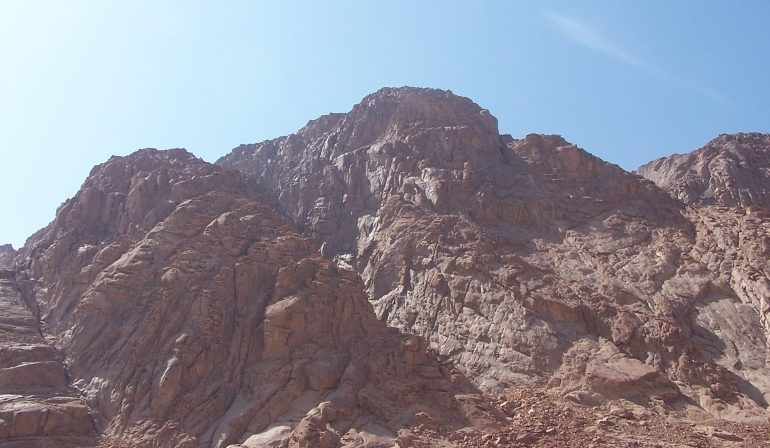
On Mount Sinai (2004)
Poem for Symphonic Wind Band
- Duration: ca. 17 minutes
- Picc, 2 Fls, Ob, Bsn, P.Cl, 3 Cls, B. Cl, Shofar (ad libitum), 2 A. Sxs, T. Sx, B. Sx, 4 Hns, 4 Tpts, 3 Tbns, Bar, 2 Tbas, Str. Bass, Timp, Perc (5).
The performance of the poem begins with narration of the following scene from the Bible:
And it came to pass on the third day in the morning,
that there were thunders and lightnings,
and a thick cloud upon the mountain, and the sound of a shofar exceeding loud;
so that all the people in the camp trembled.
And Moshe brought the people out of the camp to meet with GOD;
And they stood at the foot of the mountain.
And mount Sinay smoked in every part,
because the LORD descended upon it in fire:
and the smoke of it ascended like the smoke of a furnace,
and the whole mountain quaked greatly.
And then the voice of the shofar sounded louder and louder…
…And all the people perceived the thunderings, and the lightnings,
and the sound of the shofar, and the mountain smoking:
and when the people saw it, they were shaken, and stood afar off…
…And the LORD came down upon mount Sinay,
on the top of the mountain…”
EXODUS 19 (16 – 19), 20 (15), 19 (20).
In 2004, M. Delman and the Petach Tikva Conservatoire Wind Orchestra premiered this work in Israel. They performed it again at the wind orchestra competition in Interlaken, Switzerland, and then two days later at the Mid-Europe festival in Shladming, Austria.
The evening after the performance in Interlaken, M. Delman felt strong pain, caused by acute appendicitis. He was hospitalized and had emergency surgery.
We were sure that the performance in Shladming would have to be cancelled, but, two days later, M. Delman went on to conduct his orchestra at the festival!
Such was his strength of will and creative dedication!
Below is the recording from the premiere.
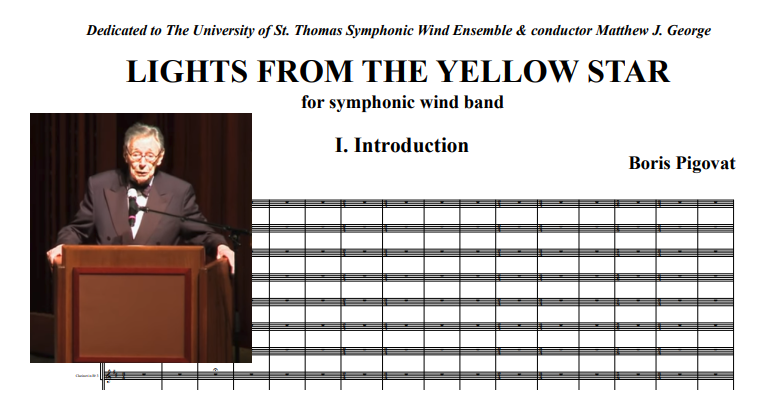
Light from the Yellow Star (2011)
For Symphonic Wind Band
- Duration: ca. 40 minutes
- Picc, 2 Fls, A.Fl, Obs, Bsns, P.Cl, 3 Cls, B.Cl, C-b.CL, S.Sx (= A.Sx.1), 2 A.Sxs, T.Sx, B.Sx, 4 Hns, 5 Tpts, 4 Tbns, Bar, 2 Tbas, Str.B, Synth, Timp, Perc (5), Solo Soprano.
In 2010, Matthew J. George, a conductor of the University of St. Thomas Symphonic Wind Ensemble, proposed that I write a composition based on books and paintings by the Holocaust survivor Dr. Robert O. Fisch.
Inspired by Dr. Fisch works, I wrote a suite of five parts:
I. Introduction
II. When the Stones weep
III. 1956
IV. Silent Music
V. Song of Love and Hope
The premiere took place in Minneapolis, in 2011, with the participation of Dr. Fisch himself; he read fragments from his books before each part of the suite and at the end of the composition. His paintings were demonstrated on a large screen during the performance. Dr. George even brought a dance ensemble for the performance!
It was extraordinary event with a big emotional impact on the audience. I invite you to view it (below are eleven clips from the premiere):
Later Matthew J. George and the University of St. Thomas Symphonic Wind Ensemble recorded Light from the Yellow Star, which was released in 2016 by the Innova label, as part of their album Persistence.